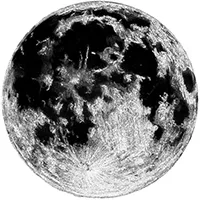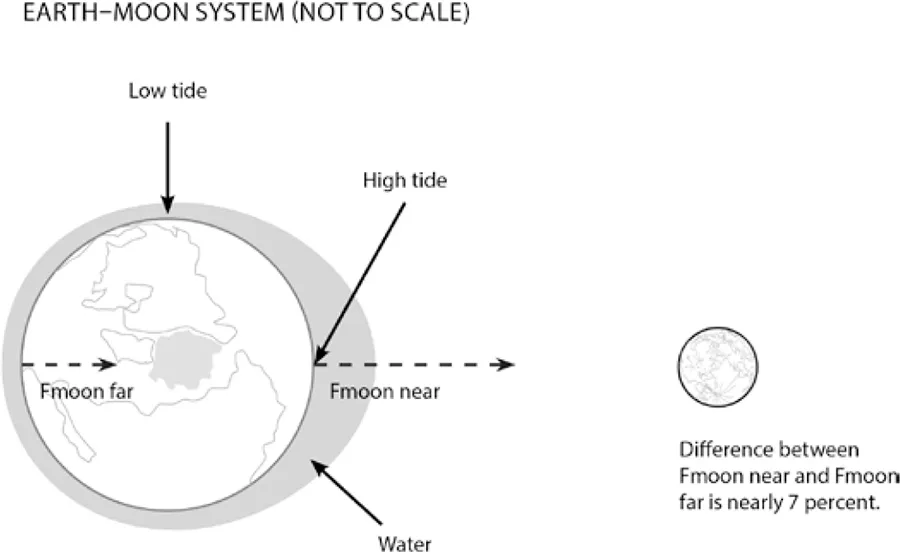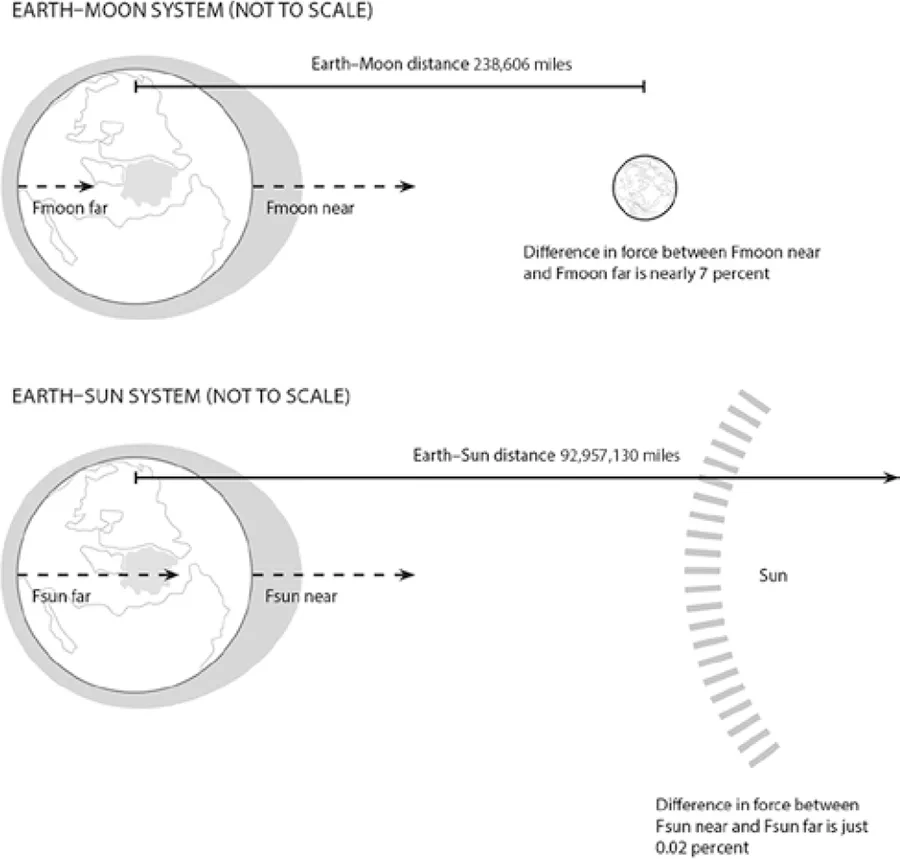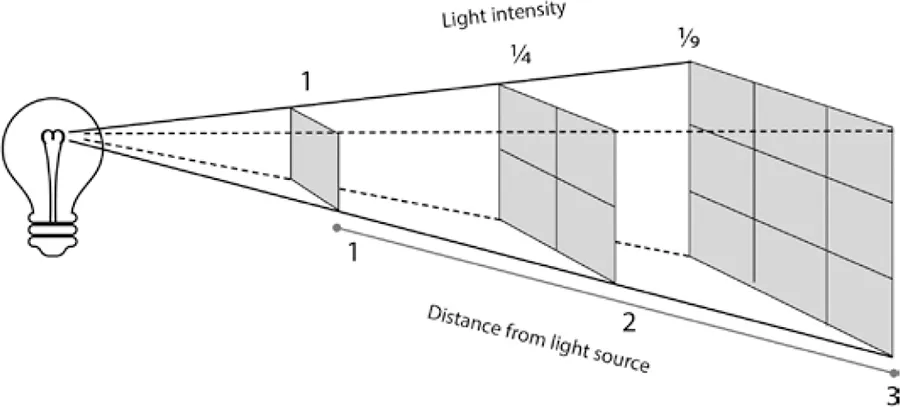
- 219 pages
- English
- ePUB (mobile friendly)
- Available on iOS & Android
eBook - ePub
About this book
The BBC's "face of space" explores all things lunar in this comprehensive guide to the folklore, facts, and possible futures of our only natural satellite.
Have you ever wondered if there are seasons on the moon or if space tourism will ever become widely accessible? So has Dr. Maggie Aderin-Pocock, astronomer and host of the BBC's docuseries, The Sky at Night. In this lucidly written guide, Aderin-Pocock takes readers on a fascinating lunar journey.
Aderin-Pocock begins with a basic overview—unpacking everything from the moon's topography and composition to its formation and orbit around the Earth. She examines beliefs held by ancient civilizations, the technology that allowed for the first moon landing, a brief history of moongazing, and how the moon has influenced culture throughout the years. Looking to the future, she delves into the pros and cons of continued space travel and exploration.
Throughout the book are sidebars, graphs, and charts to enhance the facts as well as black-and-white illustrations of the moon and stars.
Have you ever wondered if there are seasons on the moon or if space tourism will ever become widely accessible? So has Dr. Maggie Aderin-Pocock, astronomer and host of the BBC's docuseries, The Sky at Night. In this lucidly written guide, Aderin-Pocock takes readers on a fascinating lunar journey.
Aderin-Pocock begins with a basic overview—unpacking everything from the moon's topography and composition to its formation and orbit around the Earth. She examines beliefs held by ancient civilizations, the technology that allowed for the first moon landing, a brief history of moongazing, and how the moon has influenced culture throughout the years. Looking to the future, she delves into the pros and cons of continued space travel and exploration.
Throughout the book are sidebars, graphs, and charts to enhance the facts as well as black-and-white illustrations of the moon and stars.
Frequently asked questions
Yes, you can cancel anytime from the Subscription tab in your account settings on the Perlego website. Your subscription will stay active until the end of your current billing period. Learn how to cancel your subscription.
At the moment all of our mobile-responsive ePub books are available to download via the app. Most of our PDFs are also available to download and we're working on making the final remaining ones downloadable now. Learn more here.
Perlego offers two plans: Essential and Complete
- Essential is ideal for learners and professionals who enjoy exploring a wide range of subjects. Access the Essential Library with 800,000+ trusted titles and best-sellers across business, personal growth, and the humanities. Includes unlimited reading time and Standard Read Aloud voice.
- Complete: Perfect for advanced learners and researchers needing full, unrestricted access. Unlock 1.4M+ books across hundreds of subjects, including academic and specialized titles. The Complete Plan also includes advanced features like Premium Read Aloud and Research Assistant.
We are an online textbook subscription service, where you can get access to an entire online library for less than the price of a single book per month. With over 1 million books across 1000+ topics, we’ve got you covered! Learn more here.
Look out for the read-aloud symbol on your next book to see if you can listen to it. The read-aloud tool reads text aloud for you, highlighting the text as it is being read. You can pause it, speed it up and slow it down. Learn more here.
Yes! You can use the Perlego app on both iOS or Android devices to read anytime, anywhere — even offline. Perfect for commutes or when you’re on the go.
Please note we cannot support devices running on iOS 13 and Android 7 or earlier. Learn more about using the app.
Please note we cannot support devices running on iOS 13 and Android 7 or earlier. Learn more about using the app.
Yes, you can access The Book of the Moon by Maggie Aderin-Pocock in PDF and/or ePUB format, as well as other popular books in Physical Sciences & Astronomy & Astrophysics. We have over one million books available in our catalogue for you to explore.
Information
MOON PRESENT:

A SHARPER FOCUS
WHAT’S THE Moon ever done for us?
It’s the classic Monty Python notion that it gives us the tides, but how else can a ball of rock in space help us here on Earth?
I’ve always loved the Moon, but I think that, like many people, I have taken it a little for granted, not appreciating all that it does for us. So in this chapter, I want to explore the relationship we have with our closest neighbor in more depth. I want to find out what the Moon does for us day to day, and what would happen here on Earth if the Moon were closer or farther away.
THE RAW POWER OF THE MOON
Let’s start with the basics: the tides. We have all seen the effects of rising or falling water on the beach or in a river, perhaps, and we can clearly observe high tide and low tide at differing times of day. But to see one of the great tidal wonders of the world, we need to travel to the west coast of Scotland, to a place called the Falls of Lora.
Here, every six hours water from the Atlantic Ocean pours into Loch Etive, and every six hours it pours out again. All of it—45 million tons—has to pass through a narrow channel at the Connel Bridge, creating superfast currents and white-water rapids.
Expert kayakers come from all over the world to take advantage of this lunar phenomenon. They spin, jump, and capsize their boats as they battle the falls. They have to fight hard not to be swept away. So what is happening out in space that can move around such a large amount of water down here on our planet?
Well, it is all about gravity. The Earth exerts a gravitational pull on the Moon, keeping it in orbit; but in turn, the Moon exerts a gravitational pull on the Earth, tugging at the world’s oceans, creating what’s known as a tidal bulge.
Although the tides are mainly caused by the Moon, the Sun’s gravity plays a part in the motion of the tides too. Sometimes it works to enhance the influence of the Moon and sometimes it works to diminish it, but we will cover that later. Let’s keep things simple for now and look at the Earth/Moon system.
The Moon has about a hundredth of the mass of the Earth, but, because it is located relatively close to us, it exerts a significant force. As the Earth rotates, the “pull” of the Moon affects the part of the Earth directly below it. When land is below, we don’t notice a significant movement, but if it is an ocean below, then the Moon’s gravitational force can move the water, causing it to bulge toward the Moon.
The size of the bulge is not just dependent on the size of the gravitational force, but also on the difference in the gravitational pull of one side of the planet compared with the other. On the side of the Earth near the Moon, the gravitational force (Fmoon near) is 7 percent bigger than that experienced on the far side of the Earth (Fmoon far).

Diagram showing “differential force,” causing a single water bulge on Earth.
This is called the “tidal force,” but it is not just associated with tides. It is also responsible for a range of different phenomena, including spaghettification in black holes (the process by which objects get extremely elongated as they fall in). I prefer to call it the “differential force” to keep it more general than just tides. As the Earth rotates and passes through the bulge, that location will experience high tides. At points perpendicular to this, away from the bulge (see diagram), low tide will be experienced as the water is dragged away to the high tide.
But the system is more complex than this. This scenario would give us just one high tide a day, but most places experience two. Why? Well, the reason is that, in addition to the bulge of water in the direction of the Moon, there is an equivalent bulge on the opposite side of the planet. But what is causing this?
As well as the Moon’s gravitational force, there is another force at play. This occurs due to the Earth and Moon’s rotation. We think of the Moon orbiting the Earth, and it does, but it does not orbit around the center of the Earth. Instead, both the Earth and the Moon orbit around a common point that lies between them. This point is called the “barycenter” and is the center of mass of the two bodies.
One of the things that keeps coming up when we talk about the Moon is that it is quite large compared with Earth. Because our moon is large in comparison with our planet, the point of common rotation does not sit at the Earth’s center. In fact, it’s about 2,920 miles from the center, but still well within the planet’s radius of 3,976 miles.
Let’s go back to the analogy of the two ice skaters spinning around each other that I mentioned in the first chapter (see this page). If you have two equal-mass adult skaters holding hands and spinning, then they both rotate about a common point that lies halfway between the two of them. But now let’s replace one of the adults with a child. The adult has a much greater mass than the child, so when they spin around, the child travels almost in an orbit about the adult, covering much more distance than the adult. But the adult is not stationary; seen from above, the adult and the child will both still be seen to spin around a common point between them, albeit closer to the adult—this is the barycenter that was mentioned earlier. The adult will be wobbling around this common point due to the mass of the child. This second scenario illustrates how the Earth–Moon system works, where the child is the less massive Moon, and the adult is the more massive Earth.
Now, to explain the second tide, I am going the make things really weird. Let’s say that my adult skater is wearing a rather strange costume, a doughnut-shaped rubber ring full of water. Can you picture this? I know it sounds odd. As the child and my strangely-dressed adult spin around each other, the water in the rubber doughnut starts to bulge outward, away from the child. This happens due to a rotational force known as the centrifugal force: When an object is moving in a curved path, this is an apparent force that pulls the rotating object away from the center of rotation (in this case, the barycenter). In the instance of our skaters, that is in a direction away from the child, and in our Earth–Moon system, in a direction away from the Moon.
So, on one hand, we have the gravitational force of the Moon pulling water toward it, but on the other hand, we have the centrifugal force from the rotation of the Earth pulling water away from the spin axis, which happens to be away from the Moon. So for our tidal system, we have two bulges of water, and hence two high tides. And at 90 degrees to this, we get two low tides.

Moon’s gravitational force and apparent centrifugal force causing two high tides.
OK, things got a bit strange there, but stay with me, because things are going to get stranger.
I mentioned earlier that it is not just the Moon that causes the tides, the Sun does too. The Sun is far more massive than the Moon (nearly thirty million times more massive), but it sits a lot farther away from the Earth (nearly four hundred times farther away). You might think that with this great distance the Sun’s influence on the Earth’s tides would be diminished, but this is not the case. In fact, the gravitational pull the Sun exerts on the Earth is about 180 times stronger than that of the Moon on the Earth (the Sun really is that massive). However, the Sun’s effect on the tides is less strong—indeed, it’s only about 46 percent of that of the Moon. I know, even as I write it, it doesn’t seem right, so to understand why the Moon dominates the tide, we need to look a bit closer.
As I mentioned earlier, the fact is that it is not just the size of the force that matters, but the difference experienced from one side of the Earth to the other: the differential force.
In the example of my ice skaters, there was a nice, simple system, but the fact is that the gravitational pull on the Earth by the Moon is not even. The closer you are to the Moon, the greater the pull, so one side of the Earth experiences a greater gravitational effect than the other (see the section on the inverse square law below, this page).
With the Sun it is just the same: The side closest to the Sun experiences a greater force. But with the Sun the difference experienced between one side and the other is much less, only a 0.02 percent difference, whereas with the Moon, the difference is 7 percent; hence the Moon’s effect on the tide is about 46 percent stronger than the Sun’s.

Diagram showing greater “differential force” in the Earth–Moon system compared to the Earth–Sun system measured from the center of the Earth to the center of the Moon and Sun.
Things get interesting when the Sun and Moon are pulling in the same direction to cause the tides, enhancing the pull. This occurs twice every month when there is a full moon or a new moon. When this happens, you get a super high tide because the overall gravitational force of both the Sun and Moon pulling in one direction is greater than usual. It also occurs when the Sun and Moon are opposite each other in the case of a full moon, but in this case they are working together on the two opposite bulges. These large tides are called spring tides.

Extreme high tides occur when the overall gravitational forces of the Sun and the Moon are pulling in the same or opposite directions.
The opposite of this effect occurs when the lunar and solar forces are acting at right angles to each other. In this case we see shallower tides called neap tides.
There are other factors that can affect the tides too, such as the lay of the land in terms of topography. Wind and weather patterns also can affect water level: Strong offshore winds can move water away from coastlines, exaggerating low tides, whereas onshore winds can push water onto the shore, making low tides much less noticeable. In addition, high-pressure and low-pressure weather systems can cause tides that are much higher or lower than predicted.
On average, the tidal bulge is about 3.3 feet high, but at the Falls of Lora in the west of Scotland, because of the geography of the coastline, it is four times higher, causing our spectacular phenomenon.
So that’s tides explained in a rather large nutshell, but now that we have the basics, let’s play around with the system. What if the Earth–Moon distance was different? What if the Moon was closer or farther away?
Moon on the Move
Rather than torturing our ice skaters any more, let’s think up another scenario. Both magnetism and gravity work in a similar way: The closer two bodies are, the greater the force between them. So let’s replace our skaters with a bag of iron filings and a magnet, or even better, a ferrofluid (a liquid that becomes magnetized in the presence of a magnetic field). The ferrofluid represents the water molecules in the world’s oceans, and the magnet represents the Moon. When I move the position of the magnet nearer to the ferrofluid, the force is greater, and the liquid bulges toward the magnet. But as I move the magnet away, the bulge gets smaller.
This is a basic law of physics, which explains the behavior of both gravity and magnetism. It takes the form of the “inverse square law,” and essentially it means that the closer any two bodies are, the stronger the magnetic attraction—or, for our Earth–Moon system, the gravitational attraction.

The intensity of light is inversely proportional to the square of the distance from the light source, so it is much weaker farther away from the source.
But what if we moved the Moon ten times closer, or even twenty times closer—what sort of tides would that produce?
To understand the law better, let’s consider a point of light shining in a dark room. The intensity of light radiatin...
Table of contents
- Cover
- Title Page
- Copyright Page
- Dedication
- Contents
- Introduction: Why Be a Lunatic?
- Moon 101: The Basics
- Moon Past: The Moon in Our Culture
- Moon Present: A Sharper Focus
- Moon Future: What Lies Ahead?
- Conclusion: Looking Outward
- Acknowledgments
- Index